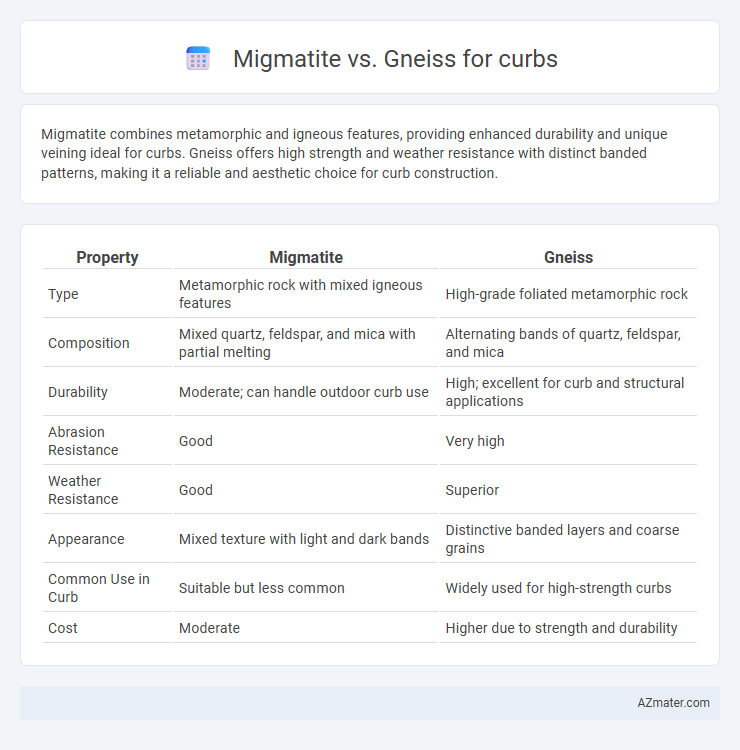Migmatite combines metamorphic and igneous features, providing enhanced durability and unique veining ideal for curbs. Gneiss offers high strength and weather resistance with distinct banded patterns, making it a reliable and aesthetic choice for curb construction.
Table of Comparison
| Property | Migmatite | Gneiss |
|---|---|---|
| Type | Metamorphic rock with mixed igneous features | High-grade foliated metamorphic rock |
| Composition | Mixed quartz, feldspar, and mica with partial melting | Alternating bands of quartz, feldspar, and mica |
| Durability | Moderate; can handle outdoor curb use | High; excellent for curb and structural applications |
| Abrasion Resistance | Good | Very high |
| Weather Resistance | Good | Superior |
| Appearance | Mixed texture with light and dark bands | Distinctive banded layers and coarse grains |
| Common Use in Curb | Suitable but less common | Widely used for high-strength curbs |
| Cost | Moderate | Higher due to strength and durability |
Introduction to Migmatite and Gneiss
Migmatite is a composite rock exhibiting characteristics of both igneous and metamorphic origins, formed through partial melting under high-grade metamorphic conditions. Gneiss is a foliated metamorphic rock characterized by distinct banding resulting from the segregation of mineral components, typically quartz, feldspar, and mica. Both rocks are valued for curbing due to their durability, unique textures, and resistance to weathering, but migmatite's mixed composition offers a more varied appearance while gneiss provides consistent, banded aesthetics.
Geological Formation and Composition
Migmatite forms through partial melting of pre-existing rocks, resulting in a mixed texture of metamorphic and igneous components, typically characterized by light quartz-feldspar veins within a darker metamorphic matrix. Gneiss, a high-grade metamorphic rock, exhibits distinct banding caused by the segregation of mineral layers like feldspar, quartz, and mica under intense heat and pressure, with no partial melting involved. Both are durable choices for curbs, but migmatite's intermingled texture often provides a more rugged appearance, while gneiss's pronounced foliation offers a visually striking, banded pattern.
Physical Appearance and Color Variations
Migmatite exhibits a striking, mixed texture characterized by light and dark bands with swirling patterns, often combining quartz, feldspar, and biotite minerals, resulting in a dynamic, variegated appearance ideal for curbs seeking visual complexity. Gneiss features well-defined, linear banding with alternating light and dark mineral layers, usually in shades of gray, white, and black, offering a more uniform and sophisticated look. Both rocks provide durable curb options, but migmatite's marbled effect contrasts with gneiss's more orderly, striped aesthetic, allowing for tailored design preferences in landscaping and urban design.
Durability and Weather Resistance
Migmatite offers exceptional durability due to its mixed composition of metamorphic and igneous materials, making it highly resistant to cracking and wear for curb applications. Gneiss is known for its layered texture and strong mineral alignment, providing excellent weather resistance against freeze-thaw cycles and chemical exposure. Both stones ensure long-lasting performance, but migmatite typically outperforms gneiss in extreme weather conditions due to its more heterogeneous and resilient structure.
Workability and Cutting Ease
Migmatite exhibits a more heterogeneous composition with alternating bands of igneous and metamorphic material, making its workability moderate but less predictable compared to gneiss. Gneiss offers superior cutting ease due to its consistent foliation and grain size, allowing cleaner edges and smoother finishes ideal for curbs. The uniform texture of gneiss reduces fabrication time and tooling wear, enhancing efficiency in curb installation projects.
Cost Comparison for Curb Projects
Migmatite typically costs more than gneiss for curb projects due to its complex formation and rarity, resulting in higher extraction and processing expenses. Gneiss offers a more budget-friendly option with abundant availability and easier quarrying, making it suitable for large-scale curb installations. When balancing durability and aesthetics against initial investment, gneiss often presents the more cost-effective solution for curb construction.
Slip Resistance and Surface Texture
Migmatite offers superior slip resistance compared to gneiss due to its heterogeneous texture combining igneous and metamorphic characteristics, resulting in a rougher surface ideal for curbs in wet or icy conditions. Gneiss features a more foliated and banded surface texture, which can be smoother and potentially more slippery when polished or wet, making it less optimal for curb applications requiring maximum traction. The coarse grain structure of migmatite enhances grip, providing safer pedestrian and vehicular contact in curb installations.
Longevity and Maintenance Needs
Migmatite offers exceptional durability for curbs due to its unique blend of metamorphic and igneous characteristics, providing resistance to weathering and mechanical stress. Gneiss, composed of alternating mineral bands, exhibits strong structural integrity and low porosity, resulting in excellent longevity with minimal maintenance requirements. Both materials require periodic sealing to preserve their surface quality, but gneiss generally demands less frequent upkeep compared to migmatite, making it a preferred choice for low-maintenance curb installations.
Environmental Impact and Sourcing
Migmatite, a hybrid rock formed from partial melting, often requires less quarrying than gneiss due to its natural formation near tectonic boundaries, reducing environmental disruption during sourcing. Gneiss, commonly quarried for curb stones, involves extensive mining processes that can lead to significant habitat disturbance and increased carbon footprint from extraction and transportation. Selecting migmatite for curbs minimizes ecological impact by leveraging its localized availability and lower processing intensity compared to gneiss's more energy-intensive production.
Conclusion: Best Choice for Curb Applications
Migmatite offers superior durability and unique aesthetic patterns ideal for curb applications requiring high strength and visual appeal. Gneiss provides excellent wear resistance and a consistent texture, suitable for heavy traffic areas demanding long-lasting performance. For curb applications, migmatite is the best choice when balancing strength and striking appearance, while gneiss excels in durability under intensive use.

Infographic: Migmatite vs Gneiss for Curb
 azmater.com
azmater.com